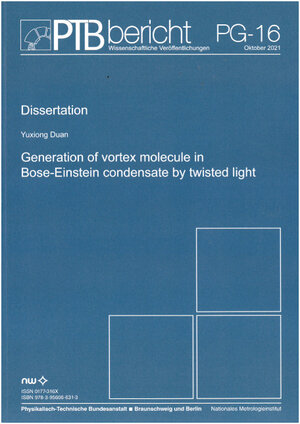Generation of vortex molecule in Bose-Einstein condensate by twisted light
von Yuxiong DuanSince its first realization in the 1990s, atomic Bose-Einstein condensate
(BEC), a novel state of matter close to 0 Kelvin, has been an active research
subject. In the last decade, studies have shown that it can be utilized as a
clean and highly controllable platform for simulating various effects of solidstate physics. One prominent example is the spin-orbit coupling (SOC),
which can be artificially induced by an external light field. In the exploration
of different SOC schemes, a special type of light, twisted light, has attracted
much attention. It is also known as optical vortex, which possesses an orbital
angular momentum in addition to its spin angular momentum. The idea is
to transfer the twisted light’s orbital angular momentum to the condensate
during the atomic transition. On the one hand, exotic spin vortices can be
sculpted in the Bose matter wave. On the other hand, this process creates
a spin–orbital-angular-momentum coupled condensate.
In this dissertation, we perform a thorough theoretical study of the above
system. We will demonstrate the creation of vortex molecule in a spinor
Bose-Einstein condensate by twisted light. To arrive at this result, our
bottom-to-top discussion will cover three topics: selection rules, spin-orbit
interaction and quantum phase transition. We first deal with the electronic
transition of a single atom induced by twisted light. We calculate the transition matrix element and derive the conditions for an allowed transition,
i. e. the selection rules. We then take a further step by considering the
center-of-mass motion of the atom. We go beyond the paraxial regime of
twisted light and investigate the dipole transition of a multilevel atom. We
show the transfer of coupled spin and orbital angular momentum from a
light to an atom. Finally, we return to the discussion of BEC by adding the
collision between atoms. This nonlinear interaction leads to a spontaneous
symmetry breaking of the system and enriches its ground-state phases. In
particular, our numerical results show exotic phases with a structure of vortex molecule. We characterize the various vortex molecules and analyze
their role in the symmetry breaking and quantum phase transitions.
(BEC), a novel state of matter close to 0 Kelvin, has been an active research
subject. In the last decade, studies have shown that it can be utilized as a
clean and highly controllable platform for simulating various effects of solidstate physics. One prominent example is the spin-orbit coupling (SOC),
which can be artificially induced by an external light field. In the exploration
of different SOC schemes, a special type of light, twisted light, has attracted
much attention. It is also known as optical vortex, which possesses an orbital
angular momentum in addition to its spin angular momentum. The idea is
to transfer the twisted light’s orbital angular momentum to the condensate
during the atomic transition. On the one hand, exotic spin vortices can be
sculpted in the Bose matter wave. On the other hand, this process creates
a spin–orbital-angular-momentum coupled condensate.
In this dissertation, we perform a thorough theoretical study of the above
system. We will demonstrate the creation of vortex molecule in a spinor
Bose-Einstein condensate by twisted light. To arrive at this result, our
bottom-to-top discussion will cover three topics: selection rules, spin-orbit
interaction and quantum phase transition. We first deal with the electronic
transition of a single atom induced by twisted light. We calculate the transition matrix element and derive the conditions for an allowed transition,
i. e. the selection rules. We then take a further step by considering the
center-of-mass motion of the atom. We go beyond the paraxial regime of
twisted light and investigate the dipole transition of a multilevel atom. We
show the transfer of coupled spin and orbital angular momentum from a
light to an atom. Finally, we return to the discussion of BEC by adding the
collision between atoms. This nonlinear interaction leads to a spontaneous
symmetry breaking of the system and enriches its ground-state phases. In
particular, our numerical results show exotic phases with a structure of vortex molecule. We characterize the various vortex molecules and analyze
their role in the symmetry breaking and quantum phase transitions.






